Last updated: June 26, 2024
Article
Eleanor Roosevelt National Historic Site Cultural Landscape
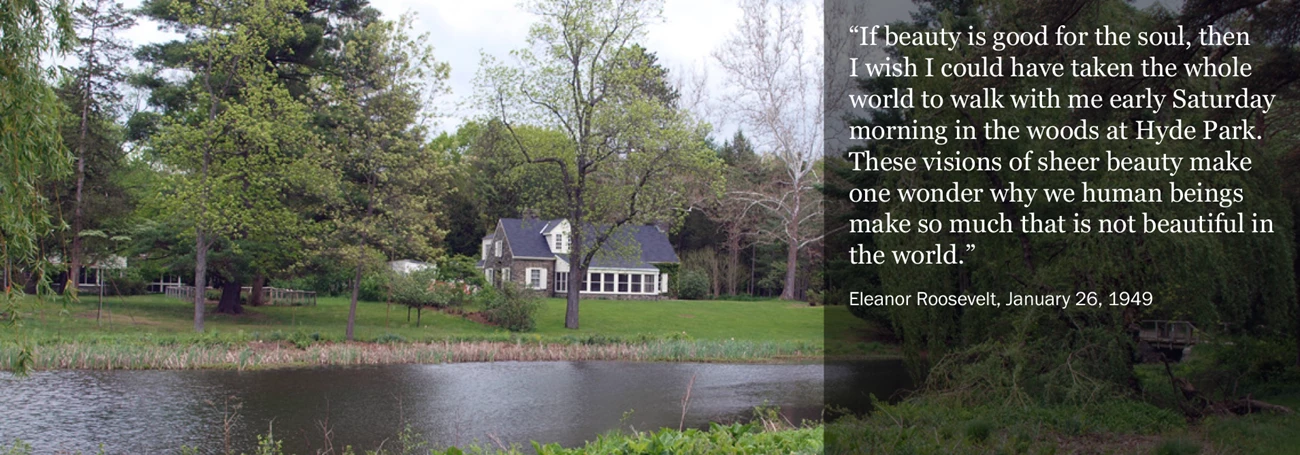
NPS
Introduction
A trailblazer and staunch human rights activist, Anna Eleanor Roosevelt, known as Eleanor, was born October 11, 1884 in New York City to two prominent families. Despite a traumatic childhood, during which she lost both her parents and a brother, Eleanor demonstrated signs of independent thinking and a commitment to community service early on as she taught the poor at the Rivington Street Settlement House and engaged in social work after completing school. In 1903, when she was just 18, Franklin Delano Roosevelt, her fifth cousin once removed, proposed to her. Although Franklin’s mother opposed the pairing, the two wed in 1905 and had six children between 1906 and 1916.
Eleanor and her family lived in Hyde Park, New York, with Franklin’s mother at the Roosevelt family’s Springwood house (which is also now a National Historic Site). After being stricken with polio in 1921, Franklin and Eleanor, together with Eleanor’s friends Nancy Cook and Marion Dickerman, found refuge from the formality of Springwood at a rustic picnic area on the banks of the Fall Kill, on land Franklin had purchased in 1911. With his support, Eleanor, Nancy, and Marion began developing the site into a year-round retreat that they named Val-Kill, the Dutch derivation of Fall Kill, meaning waterfall stream. In 1926, the first building, known as Stone Cottage, was completed.
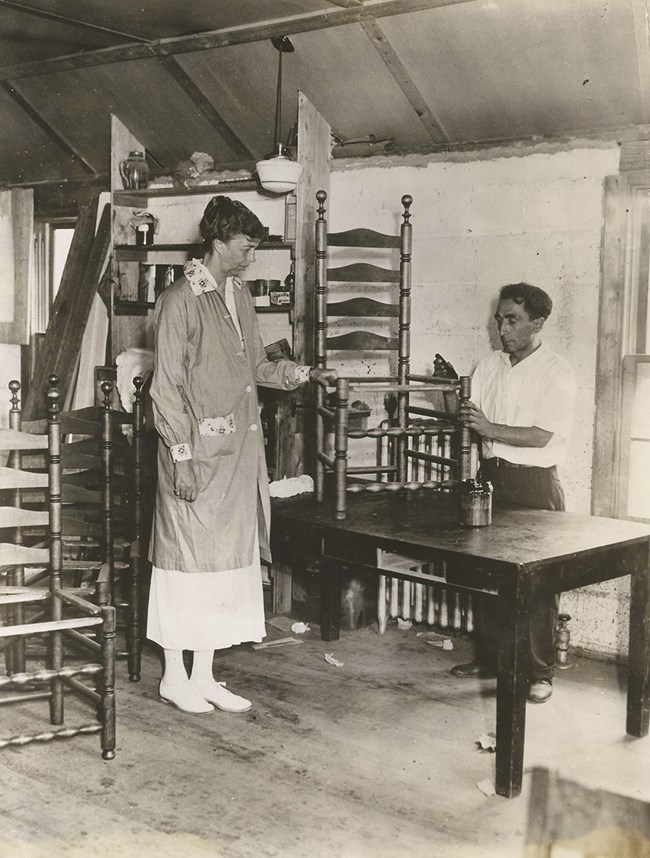
NPS
Throughout the 1920s, Eleanor became increasingly involved in activism and politics, in part to better support the ambitions of her husband who had never fully recovered from his bout with polio. Besides aiding him and giving speeches on his behalf, Eleanor vigorously campaigned for causes she also strongly believed in, such as women’s rights and advancing race relations. She and her friends often gathered at Stone Cottage to discuss social causes and propose potential solutions. One such idea they developed was the creation of Val-Kill Industries, established in 1926 to provide job opportunities to underemployed farmers in the area by teaching them handicrafts, including furniture, metal, and cloth making. A two-story building known as the Factory was completed north of Stone Cottage to house the workshops. Val-Kill Industries was ultimately dissolved due to pressures from the Great Depression and converted into Eleanor’s cottage in 1938. While Val-Kill Industries did not survive, Franklin and Eleanor incorporated its ideals in development of New Deal work-relief programs.
Upon the election of her husband, Eleanor became the First Lady of the United States in 1933. As Franklin crafted the New Deal and instituted reforms, including higher taxes on the wealthy and the introduction of Social Security, Eleanor became the president’s “eyes and ears.” She traveled to nearly every state to understand the struggles of the average American, from the poor in Appalachia to the African Americans who faced barriers to voting and social programs. By sharing her experiences and views, Eleanor played a pivotal role in Franklin’s policy. Besides influencing Franklin, Eleanor acted on her beliefs in other ways such as by joining the board of the NAACP (National Association for the Advancement of Color People), campaigning to remove the discriminatory poll tax, and giving press briefings exclusively for female reporters who were often shut out of such job opportunities due to gender discrimination. Even during World War II, Eleanor remained politically and socially active as she privately urged her husband to accept more Jewish refugees and close the Japanese American incarceration centers. Additionally, she visited wounded soldiers in Europe.
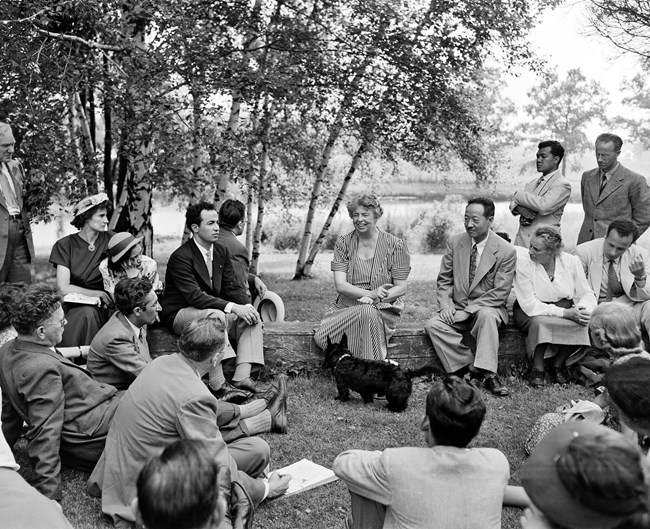
United Nations Photo / KB
When she was appointed as the US Representative to the General Assembly of the United Nations by President Truman, Eleanor had the opportunity to share the ideologies she had developed at Val-Kill over the years on a global scale. At Val-Kill, she served as the first Chairperson of the United Nations Commission on Human Rights and helped to draft the Universal Declaration of Human Rights in 1948. This monumental document outlined the basic rights that should be afforded to all people, regardless of race, religion, gender, or creed. Eleanor’s advocacy for social and civil rights issues were incorporated into many of her 27 books, 2,500 articles, and over 550 columns. Much of this content was conceived at Val-Kill, where she often drew fitting metaphors from nature for the people and social issues she wrote about.
Upon her husband’s death, Eleanor established Val-Kill as her permanent home, intent on continuing her endeavors. Indeed, she remained involved in politics partially through the discussions she had with the foreign dignitaries, politicians, and advocacy groups she invited to her cottage, including Soviet Premier Nikita Krushchev, Democratic presidential candidate John F. Kennedy, and the NAACP. In addition, she regularly hosted Encampment for Citizenship workshops on the grounds, where young people of all backgrounds and races could come together to discuss civic responsibility, political activism, and pressing social issues. Eleanor also held picnics at Val-Kill for the troubled boys of the Wiltwyck School, a nearby reform school which taught and rehabilitated boys of all racial backgrounds in addition to university students. Through her multiple, diverse engagements, Eleanor demonstrated her commitment to aiding both the youth and the future of the country. Although her views were not always welcomed, as clearly indicated in the 1950s when the KKK placed a $25,000 bounty on Eleanor for her work with the NAACP and support for an anti-lynching bill, Eleanor never wavered in her convictions.
Landscape History
While Val-Kill was the backdrop for Eleanor and many other prominent figures throughout the 20th century, its history extends back centuries. Located in the Hudson Valley in New York, the 181-acre Eleanor Roosevelt National Historical Site and surrounding area was for centuries home to the Algonquian-speaking Wappinger people. European colonization and settlement in the 1600s decimated the Wappinger people due to disease and conflict, and by the end of the century, many of those remaining fled their homeland. The Wappinger lands around Val-Kill were deeded to wealthy land speculators in the Great Nine Partners Patent issued by the royal governor of New York in 1697. After negotiating the purchase of a large swath of the territory, New York governor, Benjamin Fletcher, divided the land into nine parcels and distributed them amongst wealthy gentlemen from 1685 to 1706.
Franklin Delano Roosevelt’s family had deep ties to the Hudson Valley. In 1867, his father, James Roosevelt, purchased 110 acres of land and a large farmhouse named Springwood, which would serve as the Roosevelt family’s country home for the next eighty years. Val-Kill, which originally served as farming land and grazing fields, was originally purchased by Franklin in 1911. In addition to Fall Kill creek, the rustic landscape prominently featured pastures, trees, wetlands, brushes, and rocky terrain. During the later 1920s, the creek was eventually dammed into Val-Kill Pond where it became a central feature around which the main buildings, Stone Cottage and Val-Kill Cottage, were arranged. Franklin eventually set out lawns, gardens, woodlands, and forest plantations to surround the structures.
Val-Kill Property Construction
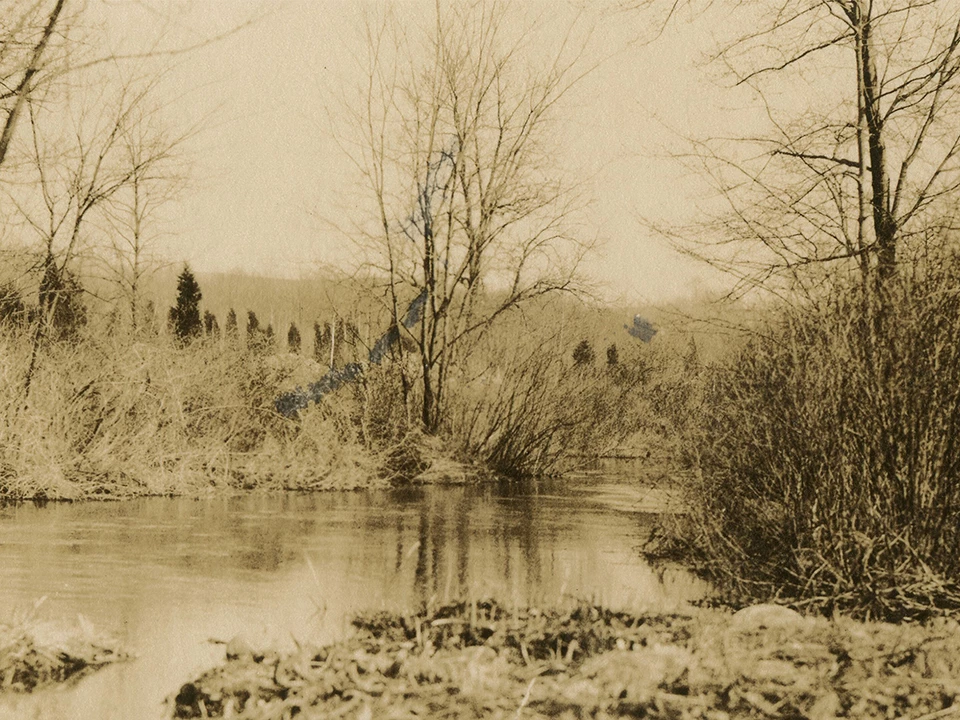
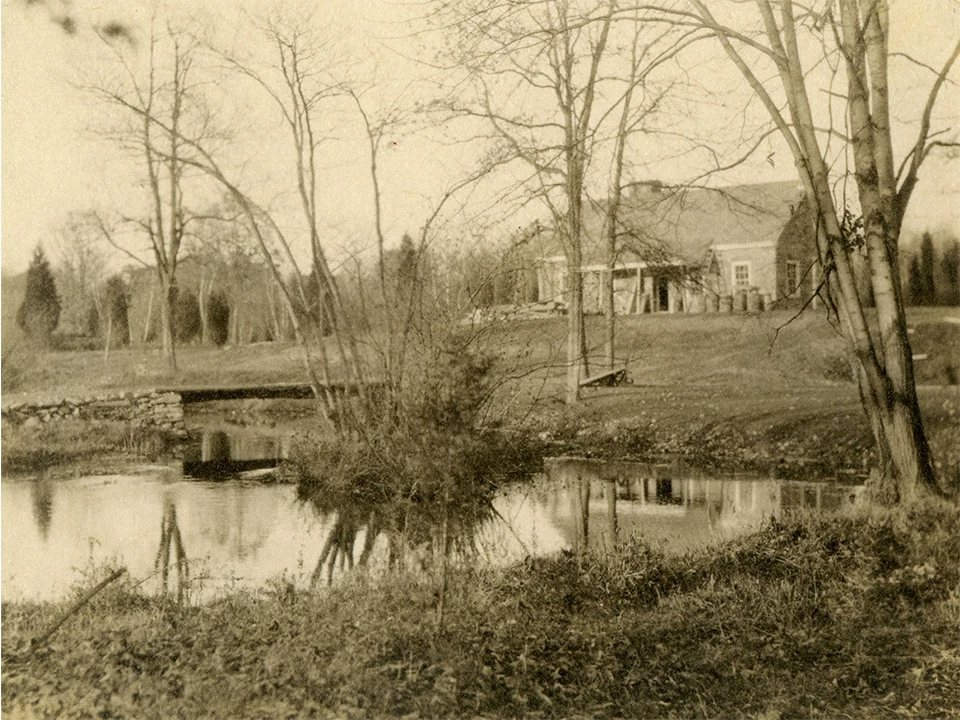
Left image
Val-Kill property before construction (prior to 1925).
Credit: NPS / Cook-Dickerman Collection
Right image
Val-Kill Construction, 1925
Credit: NPS / Cook-Dickerman Collection
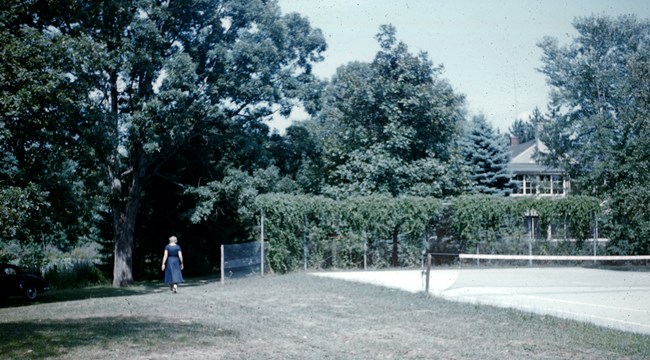
NPS / Marion Dickerman Slides
Eleanor’s role as First Lady from 1933 to 1945 required her to spend most of her time staying in Washington D.C. or traveling around the country. Despite this, she and Franklin continued to add amenities to their retreat at Val-Kill. Additional improvements were made to the landscape by Eleanor’s friends Nancy and Marion, who lived at Stone Cottage year-round. Furthermore, as Val-Kill was a place for family and friends, the landscape included recreational features such as a swimming pool, tennis court, stable, large stone fireplace, walking trails, and picnic grounds. Val-Kill also served as more than just a recreational retreat for the Roosevelts, they often met here with foreign dignitaries including Winston Churchill, King George VI and Queen Elizabeth of England. The landscape offered a relaxed setting that was a pleasant contrast to their typical meeting environment.
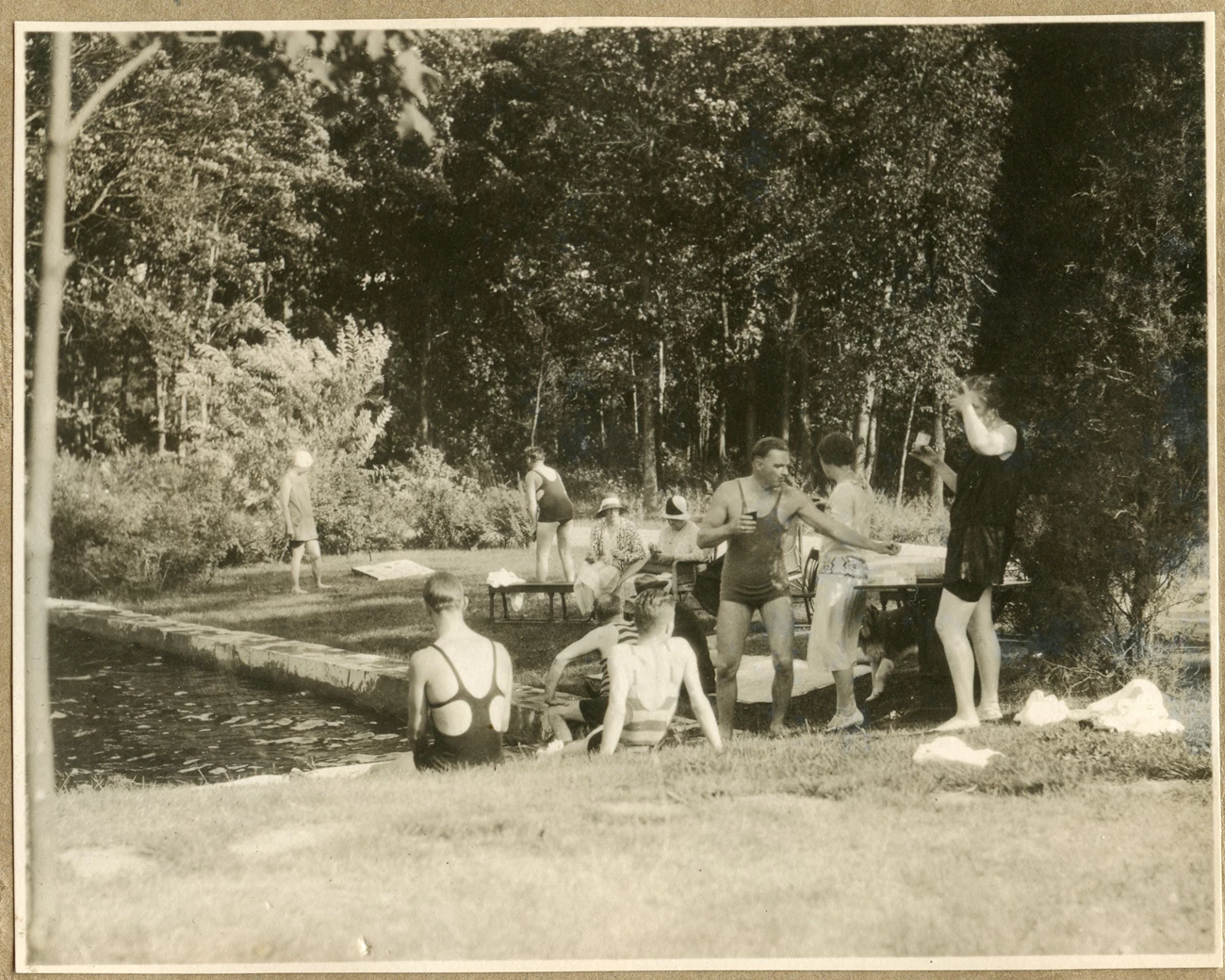
NPS
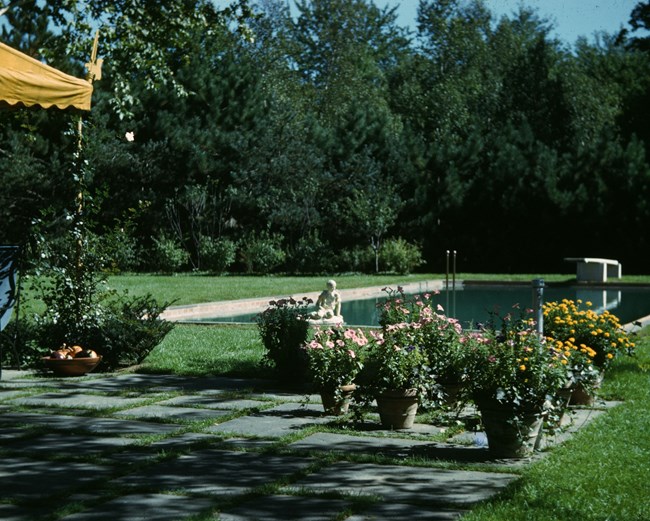
NPS / Cook-Dickerman Collection
After Franklin died in 1945, Eleanor decided to make Val-Kill her permanent home while her friends Nancy and Marion sold their shares in Val-Kill just two years later. Eleanor continued to live at her cottage while her son John and his family moved into Stone Cottage. The landscape remained well-used as a gathering place for family, friends, and dignitaries, but had an overall less formal character than the years when Nancy and Marion lived there.
Upon Eleanor’s death in 1962, the landscape fell into disrepair as its use remained uncertain. Eight years later the Roosevelt family sold Val-Kill to a developer who announced plans to demolish the house and redevelop the property. A group of concerned citizens including members of the Roosevelt family and a Hyde Park non-profit group called Eleanor Roosevelt’s Val-Kill (ERVK) rallied to save the property and preserve her legacy. These efforts led to the designation of Val-Kill as a National Historic Site in 1977, saving Eleanor’s cherished home from demolition. Its establishment as a National Historic Site began a long-term campaign to return the property to its former character during Eleanor’s lifetime. In 1984, after significant repair and restoration, Eleanor Roosevelt National Historic Site was opened to the public.
Landscape Description
Labeled Site Features
1. Val-Kill Pond
2. Fall Kill (Creek)
3. Bridge & Dam
4. Stone Cottage
5. Val-Kill Cottage
6. Playhouse
7. Tennis Court
8. Pool
9. Stable/Garage
10. Garden
11. Orchard
12. Eleanor's Walk Trail
13. Road to Top Cottage (Home of F.D.R.)
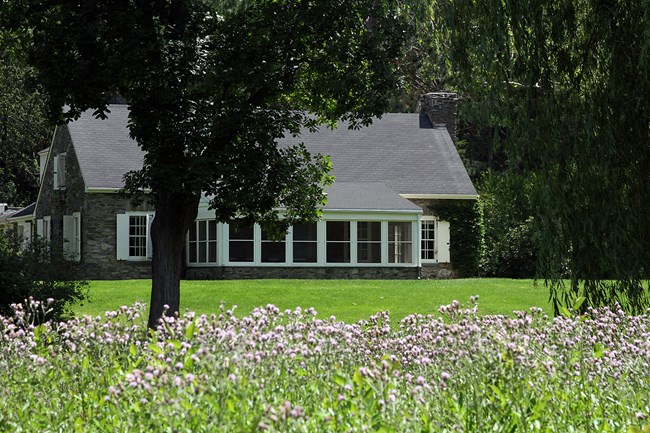
NPS / Bill Urbin
The landscape of Val-Kill that visitors see today reflects the site’s character between 1955 and 1960. These years correspond to the height of development and use under Mrs. Roosevelt's care, reflecting her appreciation for both natural landscapes as well as manicured gardens. Val-Kill contains several historic structures, such as Val-Kill Cottage and Stone Cottage. The structures exist in a domestic landscape dominated by clipped lawns, flower gardens, mature shade trees, and recreational amenities. The park contains a variety of landscape types, ranging from low-lying wetlands and cleared agricultural fields to rocky upland terrain that is heavily forested. Visitors can see the buildings as well as follow the walking trails scattered throughout the grounds that Eleanor herself often frequented to enjoy the serenity and beauty of nature.
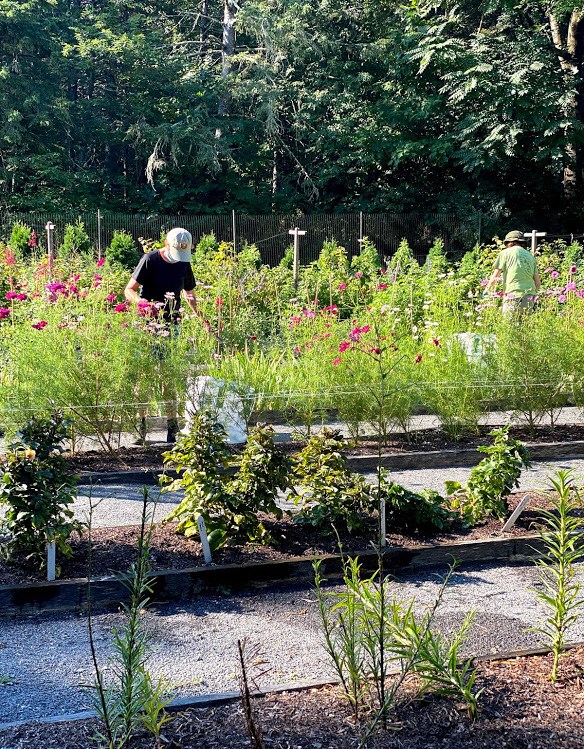
NPS
Landscape Stewardship
As a National Historic Site, Val-Kill meets the criteria of being associated with the life of a significant historical person – Eleanor Roosevelt – as well as being associated with events which were historically significant. Since its establishment as the Eleanor Roosevelt National Historic Site, Val-Kill is managed by the National Park Service and remains as the only national historic site dedicated to a First Lady.
The National Park Service and its partners have done extensive work to preserve and restore the property’s lively domestic and natural character as it was during Eleanor’s lifetime. While most of the buildings and land were well-restored by the time Eleanor Roosevelt National Historic Site opened to the public, the pool and terrace remained covered and unmaintained. The pool was a focal point of Eleanor’s bustling life at Val-Kill. It served as a place where Eleanor’s family could comfortably gather for intimate parties and where politicians could relax and discuss politics with Eleanor. In 2016, the National Park Service resolved to restore the pool and surrounding area, thus allowing the public to fully appreciate and witness the physical places tied to both Eleanor’s personal life and civil engagements.
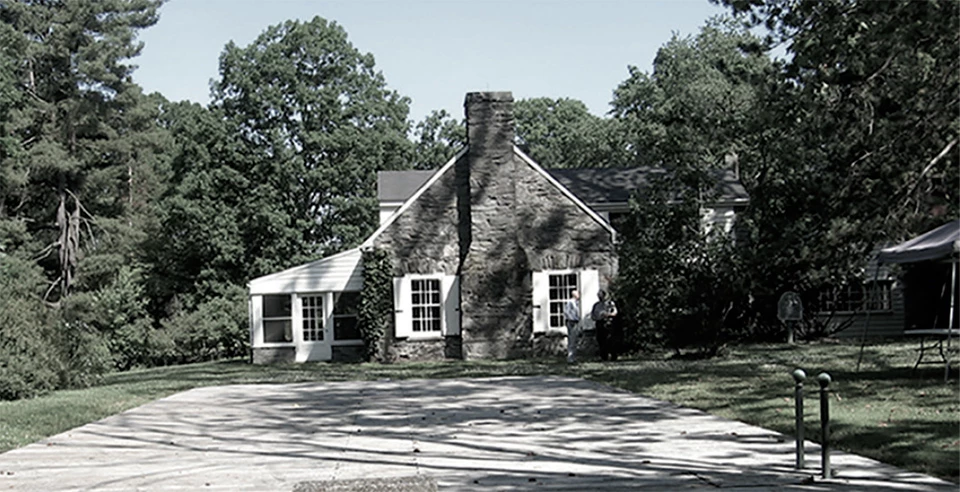
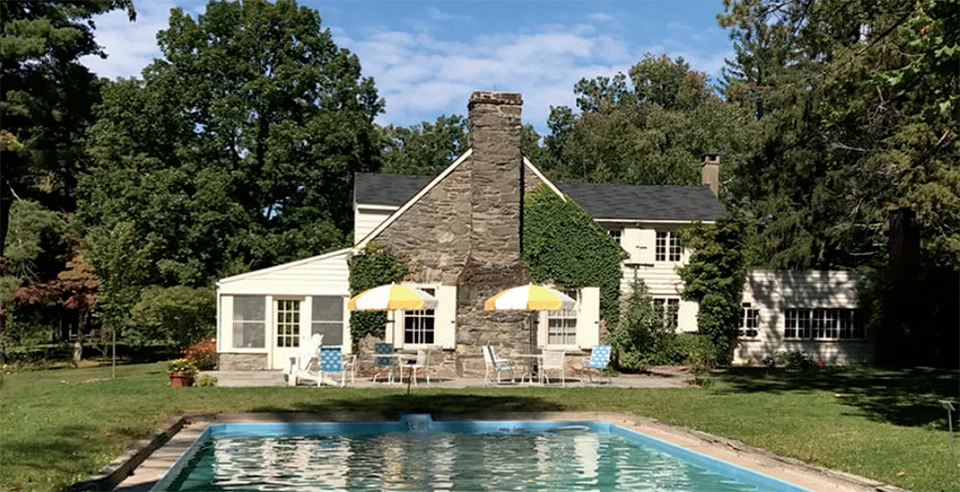
Left image
The swimming pool beside the Stone Cottage before restoration, 2014.
Credit: NPS
Right image
Pool and patio at Val-Kill after rehabilitation, 2017.
Credit: NPS
In addition to the pool, the park has undertaken several other restoration and preservation projects concerning the site, including the interior rehabilitation of Stone Cottage as well as renovations of the gardens to accurately reflect the landscape during Eleanor’s time. Under National Park Service oversight, the Eleanor Roosevelt National Historic Site is more than a historical monument. Instead, the site serves as a learning space for the public to actively experience and understand the life of Eleanor Roosevelt within the context of her beloved home.
Historic Designation Facts
- Cultural Landscape Type: Vernacular, Designed, & Historic Site
- National Register Significance Level: National
- National Register Significance Criteria:
B - Associated with lives of persons significant in our past
- Period of Significance: 1924 - 1962
More Info on this Cultural Landscape
-
Cultural Landscape Report for Eleanor Roosevelt National Historic Site, Volume II
-
Cultural Landscape Report for Eleanor Roosevelt National Historic Site, Volume I
-
Val-Kill Cultural Landscape Inventory, Eleanor Roosevelt National Historic Site
-
National Register of Historic Places: Eleanor Roosevelt National Historic Site
-
Virtual Tour of the Eleanor Roosevelt National Historic Site
-
"My Day" - Columns written by Eleanor Roosevelt between 1935 and 1962. From the Eleanor Roosevelt Papers Project, Columbian College of Arts and Sciences.




